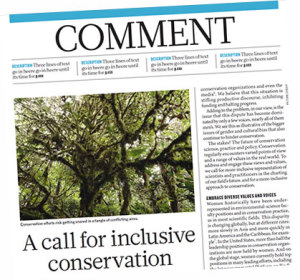 PULLMAN, Wash. – A call for inclusive conservation published in this week’s issue of the journal Nature is signed by 240 leading conservation scientists, including Stephanie Hampton, director of the Center for Environmental Research, Education and Outreach at Washington State University.
PULLMAN, Wash. – A call for inclusive conservation published in this week’s issue of the journal Nature is signed by 240 leading conservation scientists, including Stephanie Hampton, director of the Center for Environmental Research, Education and Outreach at Washington State University.
“Conservation is being held back by the field’s lack of inclusiveness — particularly of the many different values people hold for nature and of the viewpoints of women and diverse ethnicities and cultures,” Hampton said. “Essentially, we call for an end to the divisiveness.”
The scientists have created a website at http://diverseconservation.org that includes a petition of support. The site is intended to house videos and events to bring attention to the diversity of values and voices in conservation.
 Leading the call in the Nature commentary are Heather Tallis, lead scientist with the Nature Conservancy, and Jane Lubchenco, former administrator of the National Oceanic and Atmospheric Administration.
Leading the call in the Nature commentary are Heather Tallis, lead scientist with the Nature Conservancy, and Jane Lubchenco, former administrator of the National Oceanic and Atmospheric Administration.
In particular, the authors aim to move conservation beyond a “vitriolic, personal” debate that has polarized and dominated the field in recent years — pitting the idea that we must protect nature to help ourselves (nature’s “instrumental value”) against the idea that nature should be protected for its own sake (“intrinsic value”).
“This dialog is important for conservation scientists,” Hampton said. “We need to understand the potential trade-offs of invoking various values in conservation.
“But what’s happening now is an entrenched continuing debate that confuses outsiders and demoralizes conservationists,” she said. “And the absence of female voices is glaringly obvious in a field where women are otherwise so active and influential.
“People choose to conserve nature for diverse reasons,” she said. “That’s not hard for most conservationists to accept.”
To rectify the lack of diversity in values and voices, the letter’s 240 signatories propose a set of specific measures, including:
– Portraying the global history of the field and its centuries of diverse approaches to students training to be conservation scientists;
– Using social media, journals and conference fora to elevate the voices of scientists and practitioners from underrepresented genders, cultures and contexts;
– Embracing “all plausible conservation actors” — including corporations, government agencies, and faith-based organizations;
– Bringing media attention to the full breadth of conservation scientists and practitioners to counter the few polarized voices that are now gathering headlines.
Those registered with Nature may access the article at http://press.nature.com. Others may contact Alice Henchley at a.henchley@nature.com for access to a pdf.
Contact:
Stephanie Hampton, WSU Center for Environmental Research, Education and Outreach, 509-335-6750, s.hampton@wsu.edu